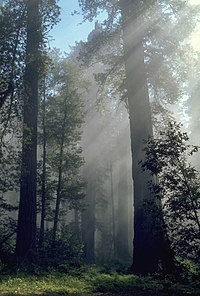
Photo from wikipedia
Plants growing in subtropical regions are often affected by high temperature and high light in summer and low temperature and high light in winter. However, few studies have compared the… Click to show full abstract
Plants growing in subtropical regions are often affected by high temperature and high light in summer and low temperature and high light in winter. However, few studies have compared the photoprotection mechanism of tree species at different successional stages in these two environments, although such studies would be helpful in understanding the succession of forest communities in subtropical forests. In order to explore the strategies used by dominant species at different successional stages to cope with these two environmental conditions, we selected two dominant species in the mid-successional stage, Schima superba and Castanopsis chinensis, and two dominant species in the late-successional stage, Machilus chinensis and Cryptocarya chinensis. The cell membrane permeability, chlorophyll fluorescence, chlorophyll content, and a few light-protective substances of these dominant species were measured in summer and winter. The results show that in summer, the young leaves of dominant species in the mid-successional stage showed higher anthocyanin content and superoxide dismutase (SOD) activity, while those in the late-successional stage showed higher flavonoid and total phenolic content, total antioxidant activity, non-photochemical quenching (NPQ), and carotenoid/chlorophyll (Car/Chl) ratio. In winter, young leaves of dominant species in the mid-successional stage were superior to those in the late-successional stage only in terms of catalase (CAT) activity and NPQ, while the anthocyanin, flavonoids, and total phenol content, total antioxidant capacity, and Car/Chl ratio were significantly lower compared to the late-successional stage. Our results show that the dominant species in different successional stages adapted to environmental changes in different seasons through the alterations in their photoprotection strategies. In summer, the dominant species in the mid-successional stage mainly achieved photoprotection through light shielding and reactive-oxygen-species scavenging by SOD, while the antioxidant capacity of trees in the late-successional stage mainly came from an increased antioxidative compounds and heat dissipation. In winter, the dominant species in the mid-successional stage maintained their photoprotective ability mainly through the scavenging of reactive oxygen species by CAT and the heat dissipation provided by NPQ, while those in the late-successional stage were mainly protected by a combination of processes, including light shielding, heat dissipation, and antioxidant effects provided by enzymatic and non-enzymatic antioxidant systems. In conclusion, our study partially explains the mechanism of community succession in subtropical forests.
Journal Title: International Journal of Molecular Sciences
Year Published: 2022
Link to full text (if available)
Share on Social Media: Sign Up to like & get
recommendations!